ANGIOTENSIN II, HUMAN
Synonym(s):Ang II;Angiotensin 2;Angiotensin II;Angiotensin II, Human - CAS 4474-91-3 - Calbiochem;DRVYIHPF
- CAS NO.:4474-91-3
- Empirical Formula: C50H71N13O12
- Molecular Weight: 1046.2
- MDL number: MFCD00161484
- EINECS: 2017-001-1
- SAFETY DATA SHEET (SDS)
- Update Date: 2024-11-17 16:00:36
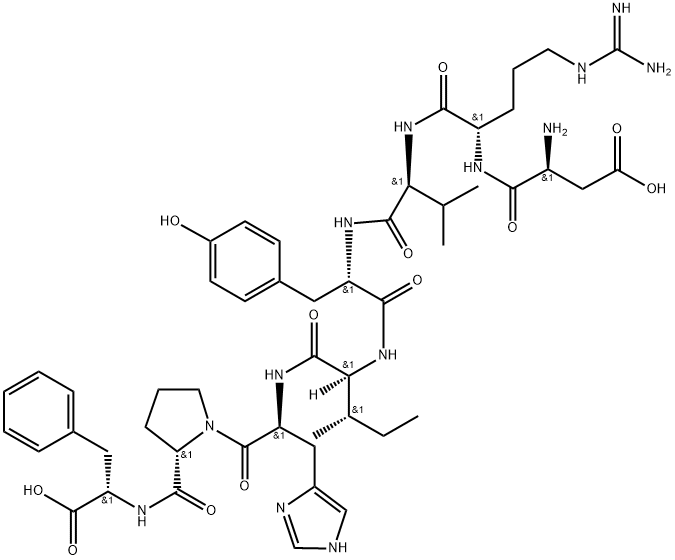
What is ANGIOTENSIN II, HUMAN?
Description
It is known that tumor tissues including metastatic lymph nodes are composed of newly growing vessels which lack blood flow autoregulation and are influenced only secondarily by the responding somatic vessels. Human angiotensin II (AT II). a vasopressor, was introduced in Japan to improve the efficacy of systemic chemotherapy. In patients with various advanced cancers, i.v. infusion of AT II to achieve a mean blood pressure of 1.5 times of baseline (but not over 150 mm Hg) followed by a bolus injection of conventional cytotoxic agents increases blood flow 5-7 fold in tumor tissues and therefore, increases drug delivery to the target tissue resulting in enhanced chemotherapeutic effects. This induced-hypertension chemotherapy regimen can be performed safely with minimal side effects.
Description
Angiotensin II is a peptide hormone known best as a vasoconstrictor with central roles in chronic hypertension, heart failure, and stroke. It is an octapeptide typically generated by the removal of two residues from angiotensin I by angiotensin-converting enzyme (ACE). Angiotensin II is a ligand for at least two distinct receptors, AT1 and AT2, each evoking distinct signaling pathways and physiological responses. The development of antagonists for specific angiotensin II receptor subtypes represents a valuable alternative to ACE inhibitors.
Originator
Toa Eiyo (Japan)
The Uses of ANGIOTENSIN II, HUMAN
Cardiopulmonary resuscitation - not yet an approved application
The Uses of ANGIOTENSIN II, HUMAN
A peptide involved in the regulation of blood pressure
The Uses of ANGIOTENSIN II, HUMAN
Angiotensin II is a peptide hormone known best as a vasoconstrictor with central roles in chronic hypertension, heart failure, and stroke. It is an octapeptide typically generated by the removal of two residues from angiotensin I by angiotensin-converting enzyme (ACE). Angiotensin II is a ligand for at least two distinct receptors, AT1 and AT2, each evoking distinct signaling pathways and physiological responses. The development of antagonists for specific angiotensin II receptor subtypes represents a valuable alternative to ACE inhibitors.
What are the applications of Application
Angiotensin II, Human is a peptide involved in the regulation of blood pressure
Definition
ChEBI: Ile(5)-angiotensin II is an angiotensin II that acts on the central nervous system (PDB entry: 1N9V). It has a role as a human metabolite. It is a tautomer of an Ile(5)-angiotensin II dizwitterion.
brand name
Delivert
General Description
Functions in blood pressure maintenance. Stimulates the release of aldosterone from the adrenal gland. Has strong vasoconstrictive effects. Increases the entry of Ca2+ in heart muscle via voltage-sensitive channels and activates myosin light chain kinase. Activates JAK2 in smooth muscle cells. Activates p125FAK and a cytosolic 115-120 kDa calcium-dependent tyrosine kinase in rat epithelial cells. Also activates pp60c-src in vascular smooth muscle cells. Inhibits adenylate cyclase activity in spontaneously hypertensive rats.
Biochem/physiol Actions
Product does not compete with ATP.
Clinical Use
Renin antagonists, ACE inhibitors, and AT1 receptor blockers have been used, in singular or multiple blockade, to treat hypertension and other RAS-related diseases. High levels of Ang II are often related to hypertension, renal failure, and cardiac fibrosis.
in vitro
Most of the known actions of Angiotensin II (Ang II) are mediated by AT 1 receptors, the AT 2 receptor contributes to the regulation of blood pressure and renal function. Angiotensin II raises blood pressure (BP) by a number of actions, the most important ones being vasoconstriction, sympathetic nervous stimulation, increased aldosterone biosynthesis and renal actions. Other Angiotensin II actions include induction of growth, cell migration, and mitosis of vascular smooth muscle cells, increased synthesis of collagen type I and III in fibroblasts, leading to thickening of the vascular wall and myocardium, and fibrosis. These actions are mediated by type 1 Ang II receptors (AT 1 ). At the cellular level, responsiveness to Angiotensin II is conferred by the expression of the two classes of angiotensin receptors (AT 1 and AT 2 ). The effects of Angiotensin II to increase blood pressure are mediated by AT1 receptors.
in vivo
To distinguish the AT 1 receptor population that is critical for the pathogenesis of hypertension, osmotic minipumps are implanted s.c. into each animal to infuse Angiotensin II (1,000 ng/kg/min) continuously for 4 weeks. Angiotensin II causes hypertension by activating AT 1 receptors in the kidney promoting sodium reabsorption.
storage
-20°C (desiccate)
Properties of ANGIOTENSIN II, HUMAN
| Boiling point: | 809.08°C (rough estimate) |
| Density | 1.1257 (rough estimate) |
| RTECS | BW2165000 |
| refractive index | 1.6700 (estimate) |
| storage temp. | Keep in dark place,Inert atmosphere,Store in freezer, under -20°C |
| solubility | insoluble in DMSO; insoluble in EtOH; ≥100.2 mg/mL in H2O |
| form | Powder |
| pka | pK1: 10.37 (25°C) |
| color | orange |
| Water Solubility | Soluble in Water (25 mg/ml), and 5% Acetic Acid (1 mg/ml). |
| Stability: | Hygroscopic |
Safety information for ANGIOTENSIN II, HUMAN
Computed Descriptors for ANGIOTENSIN II, HUMAN
| InChIKey | CZGUSIXMZVURDU-JZXHSEFVSA-N |
New Products
(S)-3-Aminobutanenitrile hydrochloride 4-Methylphenylacetic acid N-Boc-D-alaninol N-BOC-D/L-ALANINOL Tert-butyl bis(2-chloroethyl)carbamate 3-Morpholino-1-(4-nitrophenyl)-5,6-dihydropyridin- 2(1H)-one Furan-2,5-Dicarboxylic Acid Tropic acid S-2-CHLORO PROPIONIC ACID ETHYL ISOCYANOACETATE 2-Bromo-1,3-Bis(Dimethylamino)Trimethinium Hexafluorophosphate 4-IODO BENZOIC ACID 3-NITRO-2-METHYL ANILINE 1-(2,4-DICHLOROPHENYL) ETHANAMINE (2-Hydroxyphenyl)acetonitrile 4-Bromopyrazole 5,6-Dimethoxyindanone 2-(Cyanocyclohexyl)acetic acid 4-methoxy-3,5-dinitropyridine 1-(4-(aminomethyl)benzyl)urea hydrochloride 2-aminopropyl benzoate hydrochloride diethyl 2-(2-((tertbutoxycarbonyl)amino) ethyl)malonate tert-butyl 4- (ureidomethyl)benzylcarbamate Ethyl-2-chloro((4-methoxyphenyl)hydrazono)acetateRelated products of tetrahydrofuran
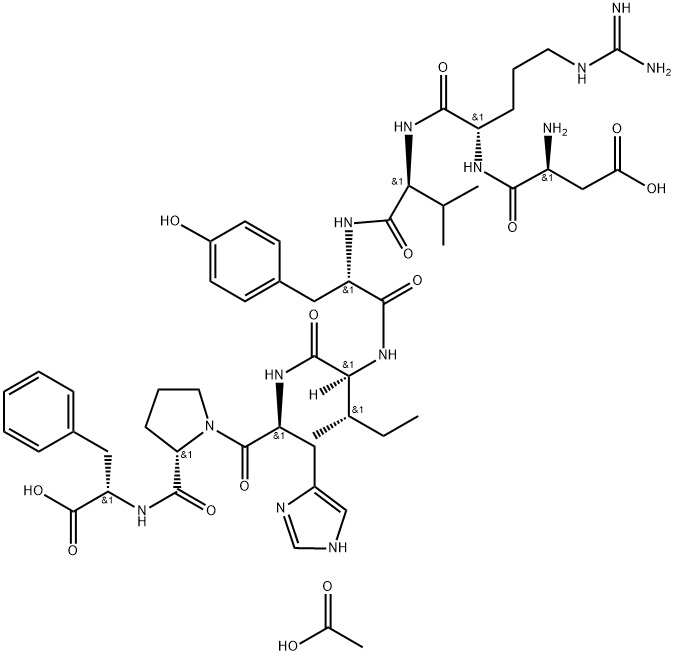
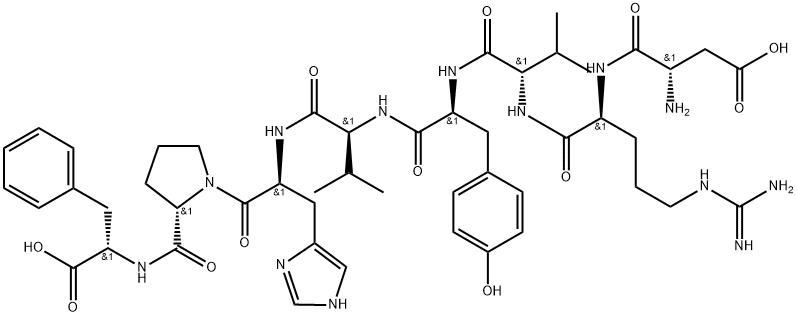
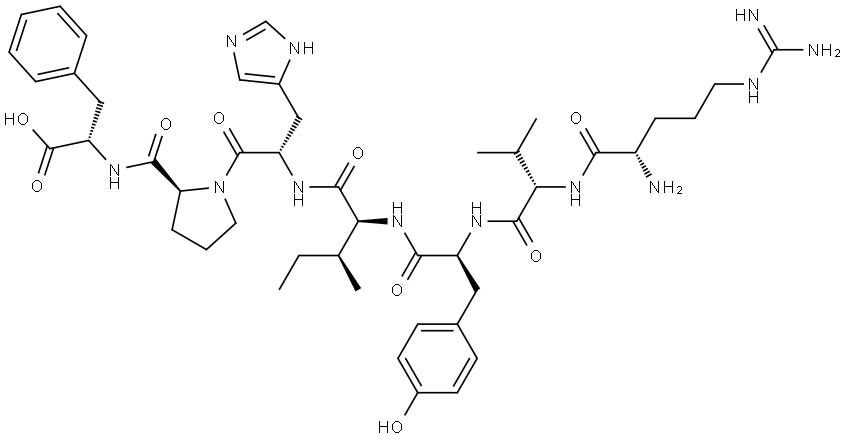
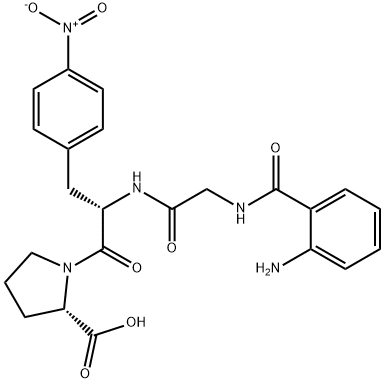


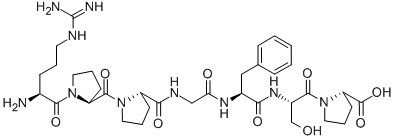
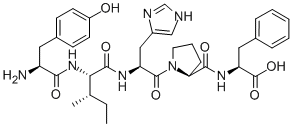
You may like
-
 Angiotensin II, Human CAS 4474-91-3View Details
Angiotensin II, Human CAS 4474-91-3View Details
4474-91-3 -
 2033-24-1 98%View Details
2033-24-1 98%View Details
2033-24-1 -
 1975-50-4 98%View Details
1975-50-4 98%View Details
1975-50-4 -
 2-HYDROXY BENZYL ALCOHOL 98%View Details
2-HYDROXY BENZYL ALCOHOL 98%View Details
90-01-7 -
 2-Chloro-1,3-Bis(Dimethylamino)Trimethinium Hexafluorophosphate 221615-75-4 98%View Details
2-Chloro-1,3-Bis(Dimethylamino)Trimethinium Hexafluorophosphate 221615-75-4 98%View Details
221615-75-4 -
 61397-56-6 CIS BROMO BENZOATE 98%View Details
61397-56-6 CIS BROMO BENZOATE 98%View Details
61397-56-6 -
 14714-50-2 (2-Hydroxyphenyl)acetonitrile 98+View Details
14714-50-2 (2-Hydroxyphenyl)acetonitrile 98+View Details
14714-50-2 -
 118753-70-1 98+View Details
118753-70-1 98+View Details
118753-70-1